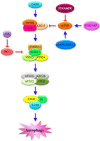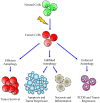Autophagy and cancer
- PMID: 24710488
- PMCID: PMC3901115
- DOI: 10.3390/cells1030520
Autophagy and cancer
Abstract
Autophagy is a housekeeping survival mechanism with a protective function against stress conditions. However, when stress severity or duration increases, it may promote cell death. Paradoxically, autophagy favors cancer development, since cancer cells could enhance their proliferation potential (thus becoming able to resist anticancer therapy) thanks to the energetic supply provided by organelle degradation typically driven by autophagy following a stepwise pathway. The main actors of the autophagic machinery as well as the features shared with apoptosis will be described. Special attention will be paid to the effects of autophagy manipulation.
Figures



Similar articles
-
The end of autophagic cell death?Autophagy. 2012 Jan;8(1):1-3. doi: 10.4161/auto.8.1.16618. Epub 2012 Jan 1. Autophagy. 2012. PMID: 22082964 Review.
-
To die or not to die: that is the autophagic question.Curr Mol Med. 2008 Mar;8(2):78-91. doi: 10.2174/156652408783769616. Curr Mol Med. 2008. PMID: 18336289 Review.
-
Modulating autophagy in cancer therapy: Advancements and challenges for cancer cell death sensitization.Biochem Pharmacol. 2018 Jan;147:170-182. doi: 10.1016/j.bcp.2017.11.021. Epub 2017 Dec 2. Biochem Pharmacol. 2018. PMID: 29203368 Review.
-
Understanding autophagy in cell death control.Curr Pharm Des. 2010 Jan;16(1):101-13. doi: 10.2174/138161210789941810. Curr Pharm Des. 2010. PMID: 20214621 Review.
-
Therapeutic strategies of drug repositioning targeting autophagy to induce cancer cell death: from pathophysiology to treatment.J Hematol Oncol. 2017 Mar 9;10(1):67. doi: 10.1186/s13045-017-0436-9. J Hematol Oncol. 2017. PMID: 28279189 Free PMC article. Review.
Cited by
-
Evaluation of ATG7 and Light Chain 3 (LC3) Autophagy Genes Expression in AML Patients.Iran J Pharm Res. 2019 Spring;18(2):1060-1066. doi: 10.22037/ijpr.2019.1100682. Iran J Pharm Res. 2019. PMID: 31531087 Free PMC article.
-
TRIM28 activates autophagy and promotes cell proliferation in glioblastoma.Onco Targets Ther. 2019 Jan 3;12:397-404. doi: 10.2147/OTT.S188101. eCollection 2019. Onco Targets Ther. 2019. PMID: 30655676 Free PMC article.
-
The role of AKT/mTOR pathway in stress response to UV-irradiation: implication in skin carcinogenesis by regulation of apoptosis, autophagy and senescence.Int J Mol Sci. 2013 Jul 24;14(8):15260-85. doi: 10.3390/ijms140815260. Int J Mol Sci. 2013. PMID: 23887651 Free PMC article. Review.
-
Mimulone-induced autophagy through p53-mediated AMPK/mTOR pathway increases caspase-mediated apoptotic cell death in A549 human lung cancer cells.PLoS One. 2014 Dec 9;9(12):e114607. doi: 10.1371/journal.pone.0114607. eCollection 2014. PLoS One. 2014. PMID: 25490748 Free PMC article.
-
Sinomenine Hydrochloride Inhibits Human Glioblastoma Cell Growth through Reactive Oxygen Species Generation and Autophagy-Lysosome Pathway Activation: An In Vitro and In Vivo Study.Int J Mol Sci. 2017 Sep 11;18(9):1945. doi: 10.3390/ijms18091945. Int J Mol Sci. 2017. PMID: 28891980 Free PMC article.
References
-
- Ferlay J., Shin H.R., Bray F., Forman D., Mathers C., Parkin D.M. Cancer Incidence and Mortality Worldwide: IARC CancerBase No. 10
-
- Philchenkov A. Apoptosis, cancer, and beyond. Cell Death Differ. 2006;13:2004–2005. doi: 10.1038/sj.cdd.4402009. - DOI
LinkOut - more resources
Full Text Sources

